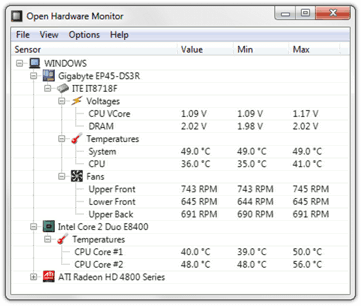
I see a number of threads regarding fan control. Martin has already determined that my HP laptop is not supported.
Jul 28, 2012 Final version of HP Fan Control has been released. (HPFanControl_setup.zip, 685 KB ) Final version of FanControl software for HP Probook 4530s. Read 'Instructions' document after installing the program. Share your experience here at notebook review forum. Reset Printer Canon Ip2770 Terbaru Y15zr on this page. Unlock when Current is not 0? Two recent threads are named 'Fan Control'.
The desktop I'm on doesn't show any options for fan control. The sensor is a Winbond/Nuvoton W83627THF. The BIOS has no hardware control at all. Driver Stampante Canon Pixma Mg5150 there. Computer is Medion, but motherboard is MS-7046, modified for Medion so many BIOS options are not available. CPU Fan is shown on Sensor Display. It's an aftermarket PWM fan & the sensor does show the rpm's varying (can hear it, too).
Something is controlling it, don't know what. I see the reading, but it is incorrect. I run the.exe & choose 'Sensor Only' & it takes a very long time for detection.
Then the Warning Message appears. Canon Ir 2016 Download Standby Message. I choose 'Continue' & it reads 963 rpm, when fan is at 0 rpm, then quit & start again & choose 'Disable Sensor'.
Same reading. Now, if run again, no error message. I am running the HP Fan Control as mentioned earlier. Waited until fan came on at around 3000rpm & your reading is in agreement with HPFC reading. When HPFC goes to 0, you're stuck at 963.
Your max reading is 7021rpm (clearly wrong!), min reading is 963. Looks like an offset (480) & a scaling error (2x), but not all the time. Fan goes off at 50C, on at 60C. Once both are running for a while & the fan comes on, your speeds agree. Exit HPFC & all is different. Fan speed read 3300 rpm (min, max, current). Restart HPFC, current & min are 963 max is 3300.
Exit HPFC, now start HPFC again. Now fan is running continuously. Fan finally shuts off & you're stuck at 963. Maybe this helps from the Instructions for HPFC HPFancontol for HP ProBook 4530s and maybe others in the series.
Tested on a 4530s with integrated HD3000 GPU. Disable 'Fan always on while on AC power' in the BIOS. Without this setting, HPFanControl will not be able to turn the fan off when you use the laptop with AC power. When the program starts, it locks the CPU temp at a low value.
This enables full control of the fan and uses the GPU temp as reference for turning the fan on/off/faster/slower. The 'fake' CPU temp can be set by editing HP32start=XX. (default=31 on 4530s) Edit XX in the first line of this.ini as the temperature where the fan would turn off on its own. To find this value on your notebook, open RW -, go the the EC (embedded controller) and double click byte 38 to edit it. Using a dec to hex converter -, start writing values lower than 39C so you can find at what temp the fan turns off. When HPFanControl closes, or when the user changes from smart or manual mode to bios mode, the program resets the real CPU temp value, by writing 00 at byte 38 and also resets the fan speed.
If on your notebook the 'reset cpu temp' value is other than 00, you can change it at 'HP32stop=xx'. Attached Files Thumbnail(s).
Since HPFC is in the Windows Startup, it is initialized & running prior to HWInfo64. I will have to disable it & see what happens. Exiting HPFC may not be the same as never running it all. 963 may only be interpreted as 0, under certain conditions.
I did verify that 'Disable 'Fan always on while on AC power' in the BIOS.' Is disabled & all my tests are while the laptop is on AC power. Once HPFC is exited, the fan starts running almost immediately, so it is difficult to get to a 0 rpm condition without it running, even with a USB powered notebook cooler. Since I don't know exactly the rated speed of the cpu fan, I only assume it's 3000rpm, so 3480 rpm is not out of line, but 7000 rpm is impossible. This is why my guess of 480 offset (963/2) & 2x scaling (7000/2 -480=3000)under certain conditions. At times the fan runs well under 3000rpm, since I believe it is PWM controlled.